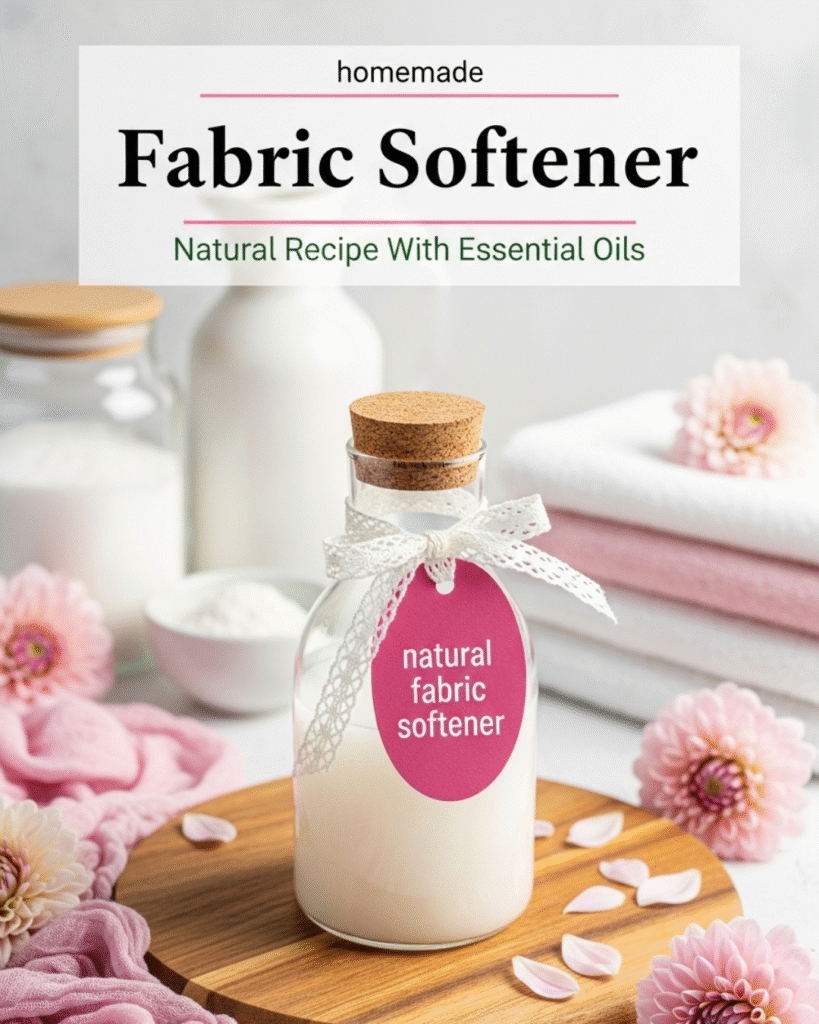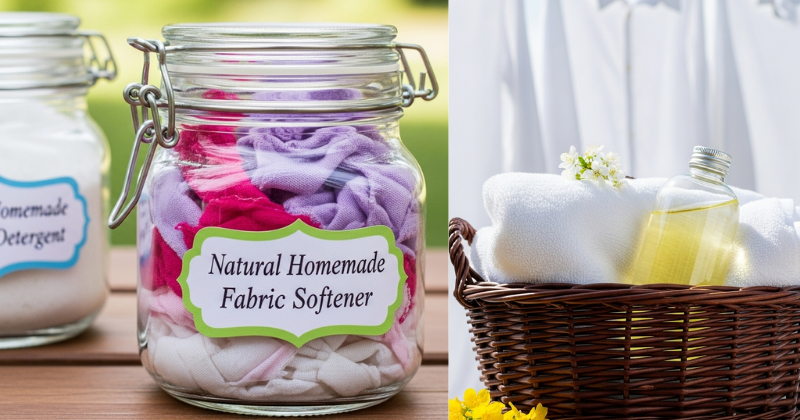Do you love the feel of soft, static-free clothes but worry about the harsh chemicals, synthetic fragrances, and cost of conventional softeners? You’re not alone! Many people are looking for a gentle, non-toxic alternative that is kinder to sensitive skin, better for the environment, and won’t damage high-tech fabrics. Learning how to use a natural fabric softener is one of the easiest and most impactful home swaps you can make. This comprehensive guide will show you simple, cost-saving DIY methods using everyday pantry staples that will transform your laundry routine, leaving your clothes incredibly soft, fresh, and free of residue. Get ready to achieve brilliantly clean and soft laundry the natural way!

🧺 Foundation First: Why Switch to Natural Fabric Softener?
Traditional liquid fabric softeners and dryer sheets work by coating your clothing fibers with a thin layer of chemical lubricants (often quaternary ammonium compounds, or “quats”). While this makes the fabric feel smooth, it comes with several trade-offs that make switching to a natural fabric softener a smart choice for your home and health.
H3: The Hidden Costs of Conventional Softeners
- Residue Build-up: The chemical coating reduces the absorbency of towels and athletic wear over time. Have you noticed your towels aren’t drying as well? The softener residue is likely the culprit!
- Irritation and Allergies: The heavy, synthetic fragrances used in commercial softeners are a common source of skin irritation, asthma, and allergies, especially for babies and those with sensitive skin.
- Fabric Damage: Softeners can break down the elasticity of spandex and synthetic fibers, which is why they are often banned for use on activewear.
- Environmental Impact: The chemicals can be harsh on septic systems and the environment once they enter the water supply.
By choosing a natural fabric softener, you avoid these issues, improve the life and performance of your clothes, and create a safer environment for your family. This is an achievable, cost-saving step toward a healthier home.
H3: The Power of Acidity and Friction
Natural fabric softener works on a completely different principle than commercial chemicals. Instead of coating the fibers with a lubricating wax, the most effective natural fabric softener uses a mild acid to neutralize alkaline detergent residue left on the fabric. This process naturally relaxes and separates the fibers, leaving them soft, while simultaneously acting as a rinsing agent to remove static-causing minerals and detergent film.
💧 Core Methods: The Two Best DIY Natural Fabric Softener Recipes
The two most effective, affordable, and readily available natural fabric softener options are white vinegar and baking soda. They are non-toxic, eco-friendly, and deliver incredible softness without the buildup.
1. The Workhorse: White Distilled Vinegar
White distilled vinegar is the champion of natural fabric softener. Don’t worry about the smell—it completely dissipates during the rinse cycle and drying process.
| DIY Vinegar Softener Recipe | Quantity | Application Method | Benefits |
| White Distilled Vinegar | 1/2 cup (120 ml) | Add directly to the fabric softener dispenser (or a Downy ball). | Removes odor, dissolves mineral buildup (descaling your machine), and reduces static. |
| Optional: Essential Oils | 10-15 drops | Mix into the vinegar bottle before use. | Adds a subtle, natural scent like Lavender or Lemon. |
Step-by-Step Process for Vinegar Softener:
- Measure 1/2 cup of white vinegar.
- Pour the vinegar directly into the liquid fabric softener dispenser of your washing machine (front-loader or top-loader).
- Run the washing machine as usual. The vinegar will be released during the final rinse cycle, where it works its magic by neutralizing the alkalinity of the detergent and softening the fibers.
2. The Dryer Sheet Alternative: Wool Dryer Balls
While liquid softeners treat the clothes in the wash, wool dryer balls are the ultimate natural fabric softener for the drying stage.
- How They Work: They reduce drying time by absorbing moisture and creating space between the clothes. More importantly, they reduce static by interrupting the friction between fabrics in the heat of the dryer.
- Application: Toss 3–6 large wool dryer balls into the dryer with your wet laundry.
- For Scent: Add 2–3 drops of your favorite essential oil (like Cedarwood or Eucalyptus) onto each ball and let them dry for 10 minutes before adding the laundry.
🍋 Advanced Strategies: Customizing Your Natural Fabric Softener
Once you master the basic vinegar and dryer ball methods, you can enhance your routine with creative variations that boost the scent, softness, and cleaning power of your natural fabric softener.
H3: Scent Boosting with Essential Oils
While commercial softeners use synthetic fragrances that linger for weeks, you can achieve a delightful, subtle scent using pure essential oils, which evaporate naturally, leaving behind only freshness, not residue.
- Calming Blends: Use Lavender or Chamomile for bedding and sleepwear.
- Energizing Scents: Try Lemon or Wild Orange for everyday laundry or cleaning rags.
- Seasonal Warmth: Cinnamon or Clove mixed with a few drops of Cedarwood can create a cozy, autumnal scent for winter garments.
Pro Tip for Oils: Never pour essential oils directly into the wash cycle; the high heat and water volume will dissipate them instantly. Always add them to the vinegar in the dispenser or directly onto wool dryer balls to maximize their effectiveness.
H3: The Baking Soda Power Wash
While vinegar works in the rinse cycle, baking soda is a fantastic natural fabric softener used directly in the wash cycle. It’s an effective deodorizer and boosts the cleaning power of your detergent.
- Method: Add 1/2 cup of baking soda (sodium bicarbonate) along with your regular detergent at the start of the wash cycle.
- Benefit: Baking soda helps balance the pH of the water, making the detergent more effective and leaving fabrics feeling naturally softer and completely odor-free. This is particularly effective for gym clothes and towels.
- (Internal Linking Opportunity: For deeper cleaning tips, read our article “How to Naturally Strip Laundry Buildup.”)
🛠️ Troubleshooting: Addressing Common Softener Issues
When switching from commercial products to a natural fabric softener, you might notice a few changes. Don’t worry! These challenges are easy to overcome and are often signs that your new routine is working to remove old buildup.
Featured Snippet Potential: “Why is my laundry still stiff after using vinegar as a fabric softener?”
Your laundry is likely stiff after switching to a natural fabric softener because of mineral buildup (hard water residue) or old detergent/softener residue that is only now being fully stripped. White vinegar is slowly dissolving this film. The solution is to perform a deep-cleaning maintenance wash (an empty hot water cycle with two cups of vinegar) to descale your machine, and then consistently use vinegar or dryer balls for a few weeks until all the old film is gone. The fibers will soften naturally once they are clean.
Solutions for Common Softening Hurdles
- Persistent Static: Static electricity is caused by dry heat and friction. If static remains, increase the number of wool dryer balls you use (up to 6) or consider adding a piece of aluminum foil balled up in the dryer. The foil acts as a grounding conductor to discharge static.
- Overwhelming Vinegar Smell: If you can still smell vinegar after drying, you are likely using too much. Reduce the amount to 1/4 cup per load. If the smell persists, your clothes may have detergent buildup that is trapping the scent. A deep cleaning soak with baking soda will fix this.
- Residue on Dark Clothes: Sometimes, powdered additives like baking soda can leave a white residue on dark fabrics if the washing machine is overloaded or uses cold water.
- Preventative Measure: Always dissolve baking soda in a cup of hot water before adding it to the wash, or ensure your machine has an optimal water level for a thorough rinse.
✅ Maximizing Results: Beyond Softness
Using a natural fabric softener isn’t just about softness; it’s a powerful tool for maintaining your washing machine, cleaning your towels, and extending the life of your garments.
H2: Maintenance and Long-Term Fabric Health
- Clean Your Machine: The mineral and soap film that hardens fabric also builds up inside your washing machine. Regular use of vinegar in the rinse cycle is the best way to naturally descale and deodorize your washing machine, which in turn leads to cleaner, softer clothes.
- Restore Towel Absorbency: If your towels feel stiff and repel water, they are coated in commercial softener residue. Run them through two hot washes: first, with 1 cup of vinegar (no detergent), and second, with 1/2 cup of baking soda (no detergent). This will completely strip the buildup and restore their fluffy absorbency. See our guide on “Eco-Friendly Cleaning: How to Maintain Your Appliances.”
- Extending Activewear Life: By avoiding chemical softeners entirely, you protect the high-performance synthetic fibers in your gym clothes, ensuring they continue to wick moisture and retain their elasticity for far longer.
This simple switch to a natural fabric softener offers achievable benefits that extend far beyond a single load of laundry, providing genuine value and supporting a cleaner, healthier home environment.
✨ Conclusion: Unlock Softer, Safer Laundry Today
You’ve discovered how simple, cost-effective, and safe it is to use a natural fabric softener like white vinegar and wool dryer balls. By making this small, powerful swap, you’ve eliminated harsh chemicals, protected your family’s skin, saved money, and extended the life of your favorite garments.
It’s encouraging to know that such simple pantry staples can transform your home care routine so dramatically. Feel the difference a clean, soft fiber makes! You are completely capable of maintaining a healthy, effective, and sustainable laundry system.
What is the first item you are going to wash using your new natural routine—your cozy sweaters or those non-absorbent towels?
